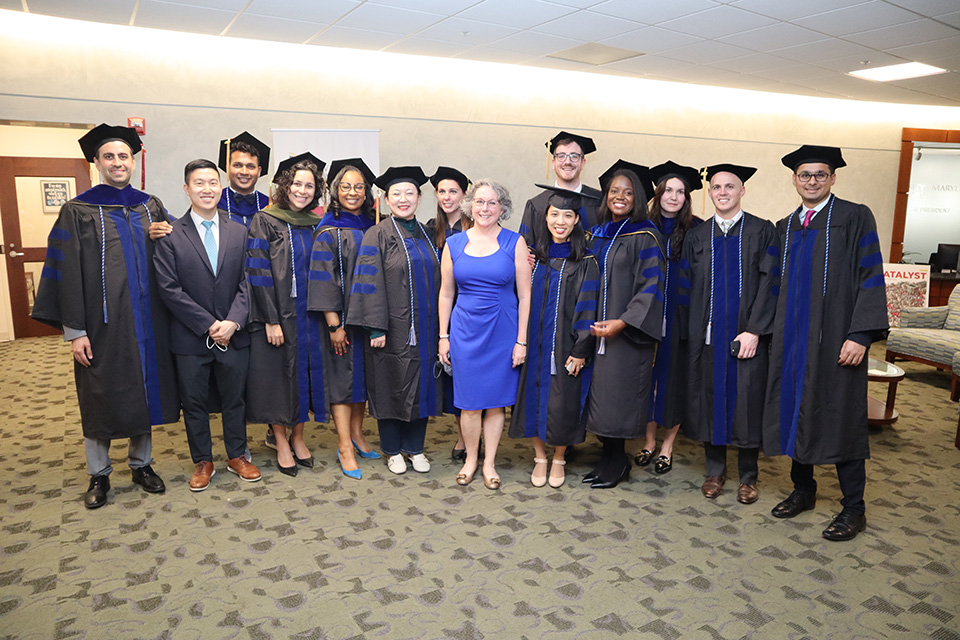PHSR Hosts Chair of International Pharmacoeconomics Task Force
Dr. Sean Sullivan gives department’s graduate students a “behind-the-scenes” look at the creation of a professional society’s budget impact guidance.
By Malissa Carroll
December 10, 2013
In preparation for the release of a new budget impact analysis guidance in the January/February 2014 issue of Value in Health, the official journal of the International Society for Pharmacoeconomics and Outcomes Research (ISPOR), the ISPOR student chapter in the Pharmaceutical Health Services Research (PHSR) graduate program at the University of Maryland School of Pharmacy hosted a lecture by Sean D. Sullivan, PhD, the Stergachis Family Endowed Professor and Director of the Pharmaceutical Outcomes Research and Policy Program at the University of Washington, earlier this semester. Sullivan co-chaired ISPOR’s Budget Impact Analysis Good Practices II Task Force, which spearheaded the creation of the new guidance.
“Dr. Sullivan is an authority on the economic evaluation of pharmaceuticals,” says Joseph Vandigo, PHSR graduate student and president of the School’s ISPOR student chapter. “His presentation provided students with an opportunity to go ‘behind-the-scenes’ in the development of an ISPOR guidance document. He brought the information to life in a way that made it understandable and enjoyable for all, regardless of their level of experience in pharmacoeconomic methods.”
Budget impact analyses are created for new pharmaceutical products to estimate their impact on a health care decision maker’s short- and long-term budget. These reports are often included as part of the product’s comprehensive economic assessment – a study that must be completed before the product can be approved for inclusion in a local or national formulary or for reimbursement.
“Those jurisdictions that are responsible for delivering and paying for health care are very mindful of their budgets,” said Sullivan. “They want to know where the money is being spent and how it will be affected if they incorporate a new drug or device. Budget impact analyses offer a practical way to synthesize knowledge and help budget holders make decisions about the best way to adopt and use a new technology.”
Sullivan received his bachelor’s degree in pharmacy from Oregon State University and completed his master’s degree in administrative and economic sciences from the University of Texas. He received his doctorate in health economics and policy from the University of California, Berkeley, and has served as the past chair of the Academy of Managed Care Pharmacy’s (AMCP) executive subcommittee on the AMCP Format for Formulary Submissions as well as the past president of ISPOR. His lecture introduced students to ISPOR’s new budget impact analysis report and reviewed key recommendations for creating budget impact models.
“This report comes from one professional society’s desire to advance the methods in the field, and to give all investigators, researchers, and emerging professionals, including students and post-doctoral fellows, access to documents that describe state-of-the-art methods in the field,” he proclaimed.
As part of his lecture, Sullivan discussed the history of ISPOR’s guidance for budget impact analyses. He noted that C. Daniel Mullins, PhD, professor and interim chair of PHSR, served with him on the task force that developed the original guidance in 2007, while also discussing the development of similar guidances in other countries, including the United Kingdom and Taiwan.
“Because the requirements for submitting financial forecasts are increasing, there are now more country-specific guidances available for the creation of budget impact models,” said Sullivan. “Specific guidance documents exist in countries as diverse as the United Kingdom, which has released its unique document on budget impact models, as well as Taiwan, which actually provides submitters of new technologies with a template to complete.”
Noting the absence of such consistency among budget impact analyses in the United States, Sullivan added, “Although we previously had no such standardization in the field, the task force recognized how useful it would be if all reports could be read by budget holders in the same way. We wanted the budget holders who receive these reports to see the same types of information every time, so we included detailed information about how to design these analyses in the new guidance.”
Sullivan also discussed other challenges that accompany these reports, including transparency and the completion of follow-up analyses. He addressed how the task force attempted to mitigate challenges in the report.
“Perhaps the biggest criticism of budget impact analyses is that the economists who develop those analyses often do not revisit the initial report to validate their forecasts,” said Sullivan. “In the new guidance, the task force makes clear that it wants to see evidence validating some of the initial forecast’s key parameters, such as the population characteristics or the adoption rates.”
He added, “The task force also emphasizes the importance of companies providing budget holders with tools that are transparent and allow the budget holder to see exactly what is happening in the forecast. There are companies that produce custom software to develop budget impact models, and they were not very pleased with this new recommendation. However, we are not in the business of helping those companies make money. We are in the business of helping budget holders use a tool.”
Following the lecture, students had an opportunity to speak with Sullivan one-on-one, where he discussed interprofessional collaboration at the University of Washington, offered his thoughts about factors that help and hinder new researchers looking to enter the workforce, and elaborated on questions related to his lecture.
“I enjoyed the way in which Dr. Sullivan discussed how decisions made for this guidance tied back to decisions made during the development of the initial guidance,” said Vandigo. “As someone with a business background, the discussion about the impact that creating transparent, standardized budget impact analyses has on the companies that design and create those analyses was also very interesting to me.”



